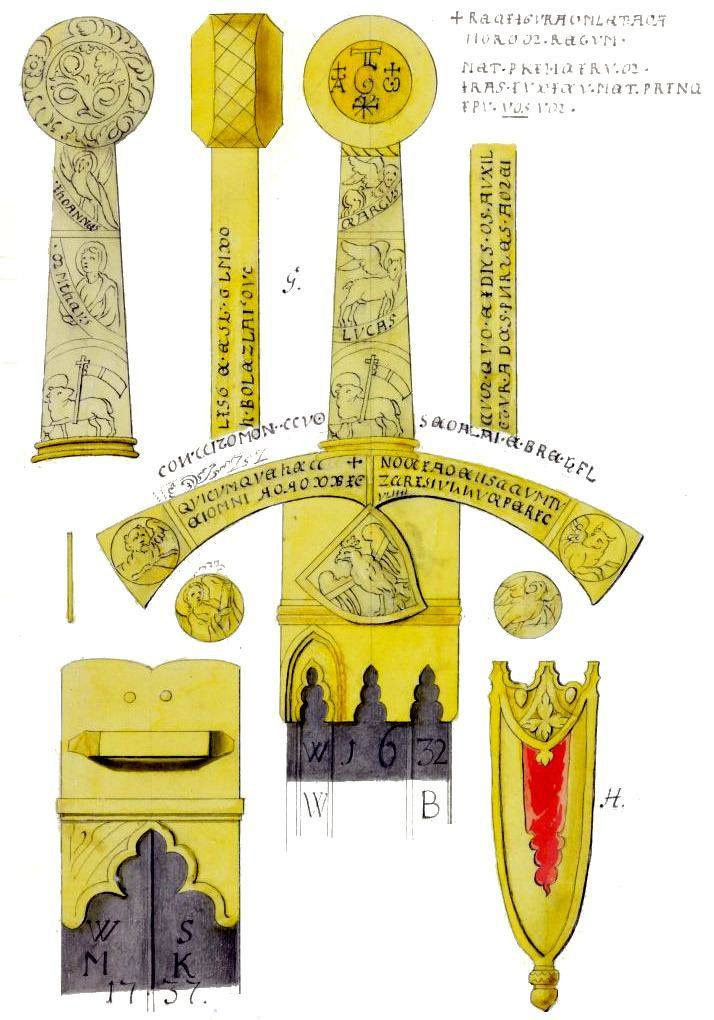🗡️ Szczerbiec: Poland’s Royal Sword and the Israelite Ensigns – A Celtic Connection Rediscovered
Celtic Press Theme
Among the treasures of European Christendom, few objects hold the mystique, symbolism, and legitimacy of the Szczerbiec, the Crowned Sword of Poland. Once wielded in the coronation of Piast kings, it has become more than an artifact — it's a key that unlocks a forgotten heritage.
🔗 Read about the sword on Wikipedia https://en.wikipedia.org/wiki/Szczerbiec
Four Creatures, Four Tribes, One Kingdom
What many overlook is the Szczerbiec’s astonishing symbolism. Engraved into its blade are four iconic emblems:
🦁 Lion – Tribe of Judah
🐂 Ox – Tribe of Ephraim
👤 Man – Tribe of Reuben
🦅 Eagle – Tribe of Dan
These are the ensign tribes described in the Book of Numbers and Ezekiel's vision — the banners placed at the four sides of Israel’s encampment around the Tabernacle (Numbers 2), and the same living creatures surrounding the throne in Revelation 4:7. They also surround Christ’s throne in traditional Orthodox church iconography.
Far from being abstract, these images were understood by medieval Christian monarchs to represent divine rule, covenantal kingship, and God's living presence with His people. The Piast kings weren’t just knowing this — they were doing it. They saw their reign in the same framework as the early Christian Celts, as part of enforcing the Kingdom of God on earth.
A Royal Blade with a Traveled Past
The Szczerbiec isn’t just metaphor — it’s real, preserved in Warsaw’s Royal Castle. It was used in nearly every Polish coronation from the 14th century until the Partitions of Poland in the late 18th century. The sword dates to around the 12th–13th century, and its name, Szczerbiec (meaning "notched sword"), comes from a legend that Bolesław the Brave struck it against the Golden Gate in Kiev as a symbol of conquest.
Historically, the sword was used for:
Oath-taking during royal coronations
A ceremonial symbol of righteous rule
A representation of the monarch’s role under divine authority
🔗 More historical context and images here
Connecting the Sword to a Forgotten Royal Lineage
Recent DNA studies out of Poland (2023–2025) have confirmed that the Piast Dynasty — the very kings crowned with the Szczerbiec — carried the R1b-L1335 haplogroup, the same lineage as the Scottish Clan Gregor chiefs, and among the most dominant Celtic royal haplogroups.
This discovery has ignited a wave of interest in Eastern Celtic studies, now a major theme in our offerings at St. Andrew’s Celtic Press — both in-store and online.
This lineage diverges from the predominant Polish population’s R1a haplogroup, estimated to have split from R1b over 5,000 years ago. While R1a likely represents other tribes (possibly Reuben or Abrahamic), R1b is dominant in Ireland, Britain, and the root of this haplogroup is among Jews. R1b DNA is widely associated with Judah and the Royal House of David.
📖 Read the DNA article here:
👉 Poland’s First Kings Belong to a Celtic Royal Dynasty
The Ancient Genetic Divide: R1b and R1a — Kindred Branches from Central Asia
It's pretty unanimous in DNA studies that about 5,000 years ago in Central Asia (or Southern Siberia), the main Celtic and Israelite branch (R1b) separated from the Polish branch (R1a). Today, the R1a DNA (and its subclades) makes up the main genetic lineage of this region — Poland and the wider Kievan Rus area (or Slavic). We believe this places them as either one of the lead tribes of Israel, or possibly even tracing back to Abraham or Shem. Most agree that the main Northwest European haplogroup R1b represents Israel and Judah, being the most dominant haplogroup of the Irish people, and that the lower roots of R1b are also a major haplogroup among Jews. However these Celtic and Slavic branches are close enough kindred branches that Biblical Hebrew law would not forbid intermarriage, though in some instances, certain inheritance rights could be affected.
Promoting Discovery Through Literature and Fellowship
This topic is the centerpiece of the next newsletter from St. Andrew’s Celtic Press, which will be given away free at Celtic festivals throughout the region. We invite readers to subscribe for ongoing insights into Celtic heritage, Israelite identity, and the Kingdom message still relevant for believers today.
🎙️ Upcoming Lecture
Rev. Dr. Stephen M.K. Brunswick — author, editor, and director of St. Andrew’s Celtic Press — will be presenting this study at the British Israel Book Club meeting in Lebanon, Missouri. The lecture will explore the sword, the royal DNA discoveries, and how it all testifies to God's enduring covenants.
📽️ The talk will be recorded and later made available to subscribers and readers on our site.
Final Thoughts
From Kiev’s gates to Galicia’s crown halls, from the Highlands of Scotland to the tribes of Israel, the symbols engraved on the Szczerbiec reflect an enduring spiritual heritage. Not merely a Polish relic, it now speaks into the modern rediscovery of Israel’s lost tribes, Celtic kingship, and the unbroken promise of divine rule.
Let the Szczerbiec be not only remembered — but reclaimed.



